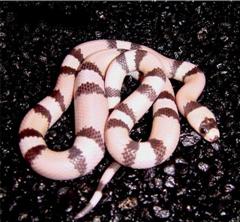Milksnake - Honduran
Honduran Milk Snake Scientific Name: Lampropeltis triangulum hondurensis
Thu, 17th April, 2025 - 8:28 am GMT
Sponsor Ads:

Alternative Name
Honduran Milk Snake Scientific Name: Lampropeltis triangulum hondurensisBasic Info
The Honduran Milksnake has the most diversity in coloration of all the milksnake subspecies; the Honduran Milksnake appears in a variety of colors and patterns. They are usually banded with yellow, black and red. The yellow bands can also be white or orange. The red bands are usually fairly wide, and both the yellow and black bands can be either very narrow, only a few scales wide, or even thicker than the red bands. The shades of the red band also differ. They can be orange, maroon, or crimson. Many snakes have saddles, pinstripe black bands, or partial stripes. Some are a shade of red with only black bands. One of the most popular colorations of the Honduran Milksnake is the "Tangerine Phase". In these snakes, the black bands are either incredibly narrow or nonexistent and both the yellow and red bands are closer to orange in color.
Health
N/AHabitat
They can be found in swamps and mountains.Behavior
The Honduran Milksnake is a beautiful snake found, as the name would suggest, in Honduras. Their coloration is very diverse. Honduran Milksnakes, especially certain color phases, such as the "Tangerine Honduran", are highly valued among collectors. The Honduran Milksnake is moderately aggressive, especially when feeding. Like other milksnakes, they feed primarily on rodents and other small mammals.Origin
Central AmericaHistory
N/ACommon Foods
They are valued as wild animals on the farm and in urban areas as they eat mice and other rodents.Sponsor Ads:
"Fanaticism consists in redoubling your efforts when you have forgotten your aim." -- George Santayana
Milksnake - Honduran
Coded by: BGID® | ALL RIGHTS RESERVED Copyright © 2000-2025
Disclaimer | Privacy | Report Errors / Contact | Credits








 President of the United States of America - Real Estate mogul, Pageant owner and now one of the most controversial men in political history.
President of the United States of America - Real Estate mogul, Pageant owner and now one of the most controversial men in political history.  Politician, US Vice President and President of the USA - Joseph Robinette Biden Jr.
Politician, US Vice President and President of the USA - Joseph Robinette Biden Jr.  versus
versus  Russia: 'The Evil Empire'? Are they all that bad or is it just the USA trying to portray Russia as bad because they are a world power with land bigger and a society very different from the USA ideal?
Russia: 'The Evil Empire'? Are they all that bad or is it just the USA trying to portray Russia as bad because they are a world power with land bigger and a society very different from the USA ideal?  Global warming has been in and out as the "latest" hot topic for many years. It is, according to modern scientists, the result of man-made industrial pollutants, clearing forested areas, agriculture, etc. But now they are thinking it started way before the Industrial Revolution...
Global warming has been in and out as the "latest" hot topic for many years. It is, according to modern scientists, the result of man-made industrial pollutants, clearing forested areas, agriculture, etc. But now they are thinking it started way before the Industrial Revolution... 
 Corona virus
Corona virus 
 Users with wide screen monitors can benefit from more content on every page.
Users with wide screen monitors can benefit from more content on every page.